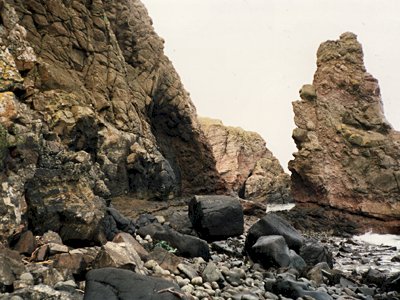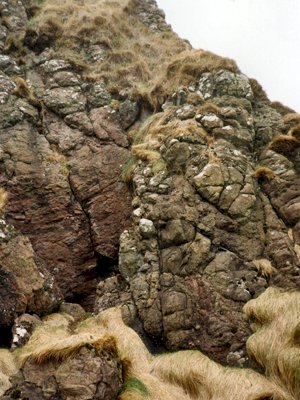Earth Science Conservation Review
| McIlroy's Port - Palaeogene | Antrim |

| Site Type: | Coastal section |
| Site Status: | ASSI |
| Council area: | Larne Borough Council |
| Grid Reference: | D453028 |
| Google maps: | 54.85229,-5.73764 |
| Rocks | |
|---|---|
| Rock Age: | Tertiary (Eocene, Palaeocene) |
| Rock Name: | Antrim Lava Group, Lower Basalt Formation |
| Rock Type: | Agglomerate, Basalt |
| Interest | |
| Minerals: | Andradite, Melilite, Nepheline, Sodalite, Spinel |
| Other interest: | amygdales, volcanic vent, zeolitization, Extrusion, Sea cliffs, marginal farmland and sheep grazing. |
Summary of site:
60 million years ago this was a site of volcanic activity, now of considerable interest and importance for its exceptional mineralogy, unique in Ireland.
In the cliffs at McIlroy's Port there is an exposure of an explosive volcanic vent that punched through a composite lava flow containing a zone of pegmatitic patches. Pegmatites are coarse-grained rocks with individual crystals more than 2.5 cm long and they generally take the form of crystal-lined cavities. During the final stages of igneous activity there is often an accumulation of volatiles that create the cavities and the conditions favouring the growth of large crystals. One of the minerals in this pegmatite is sodalite, very rare and not known to occur elsewhere in Ireland.
The lava flow is described as composite, indicating a mix of different rock compositions. The flow is very thick, around 18 m, with 15 m of olivine basalt overlying 3 m of picrite, a basalt made up of around 90% dark coloured minerals (olivines, pyroxenes and amphiboles) and around 10% of plagioclase feldspar. The flow extends for a kilometre along the coastal cliffs pinching out at both ends. The contact between the two types of lava is sharp but there is no chilling of the base of the olivine basalt against the picrite suggesting that they were both molten at the same time.
The olivine basalt has a distinctive composition with plagioclase feldspars zoned to reflect the changing chemistry of the surrounding melt as they grew. It also contains small crystals of olivine, augite and smaller grains of pyroxene and the clinopyroxene pigeonite.
The picrite is made up of 30% corroded olivine crystals in a groundmass of augite, olivine, magnetite and a variety of the feldspar plagioclase called labradorite. Differences in grainsize give it a streaky appearance. The pegmatite patches within it surround the vent and typically contain 70% titanaugite and between 10 and 20% sodalite. More recent analysis shows melilite, nepheline, perovskite, apatite and spinel, less common minerals, to be present.
The variable composition and evident banding of the flow is thought to be the result of gravity settlement of crystals in the volcanic vent before eruption mobilised and mixed them with liquid lava in the next volcanic heave. The thickness of the flow further suggests that the erupted lava accumulated in a surface depression of some sort where layers of different density settled out, the olivine tending to move to the surface. The pegmatites resulted from the final, volatile-rich, effervescence of activity.
This violent volcanic vent remained active for a considerable time and there is evidence that the heat of its lavas affected the already solidified lavas around it.
All these events occurred 60 million years ago on the reeking, ropy lava fields that slowly cooled to create the Lower Basalt Formation.
This is a superb teaching locality as well as an important research resource and has the potential to become a popular geological trail.
In the cliffs at McIlroy's Port there is an exposure of an explosive volcanic vent that punched through a composite lava flow containing a zone of pegmatitic patches. Pegmatites are coarse-grained rocks with individual crystals more than 2.5 cm long and they generally take the form of crystal-lined cavities. During the final stages of igneous activity there is often an accumulation of volatiles that create the cavities and the conditions favouring the growth of large crystals. One of the minerals in this pegmatite is sodalite, very rare and not known to occur elsewhere in Ireland.
The lava flow is described as composite, indicating a mix of different rock compositions. The flow is very thick, around 18 m, with 15 m of olivine basalt overlying 3 m of picrite, a basalt made up of around 90% dark coloured minerals (olivines, pyroxenes and amphiboles) and around 10% of plagioclase feldspar. The flow extends for a kilometre along the coastal cliffs pinching out at both ends. The contact between the two types of lava is sharp but there is no chilling of the base of the olivine basalt against the picrite suggesting that they were both molten at the same time.
The olivine basalt has a distinctive composition with plagioclase feldspars zoned to reflect the changing chemistry of the surrounding melt as they grew. It also contains small crystals of olivine, augite and smaller grains of pyroxene and the clinopyroxene pigeonite.
The picrite is made up of 30% corroded olivine crystals in a groundmass of augite, olivine, magnetite and a variety of the feldspar plagioclase called labradorite. Differences in grainsize give it a streaky appearance. The pegmatite patches within it surround the vent and typically contain 70% titanaugite and between 10 and 20% sodalite. More recent analysis shows melilite, nepheline, perovskite, apatite and spinel, less common minerals, to be present.
The variable composition and evident banding of the flow is thought to be the result of gravity settlement of crystals in the volcanic vent before eruption mobilised and mixed them with liquid lava in the next volcanic heave. The thickness of the flow further suggests that the erupted lava accumulated in a surface depression of some sort where layers of different density settled out, the olivine tending to move to the surface. The pegmatites resulted from the final, volatile-rich, effervescence of activity.
This violent volcanic vent remained active for a considerable time and there is evidence that the heat of its lavas affected the already solidified lavas around it.
All these events occurred 60 million years ago on the reeking, ropy lava fields that slowly cooled to create the Lower Basalt Formation.
This is a superb teaching locality as well as an important research resource and has the potential to become a popular geological trail.
| Enlander, I., Dempster, M. & Doughty, P., 2025. McIlroy's Port - Palaeogene, County Antrim, site summary. [In] Earth Science Conservation Review. https://www.habitas.org.uk/escr/summary.php?item=640. Accessed on 2025-04-03 |
| Previous Site | Next Site |


